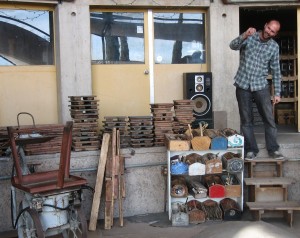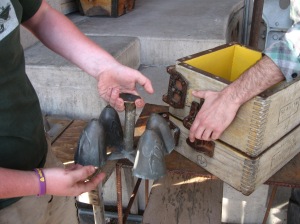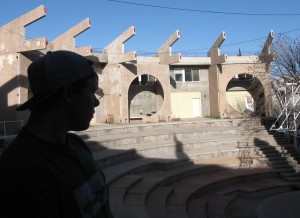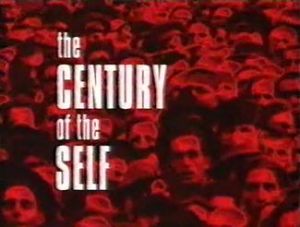Arcosanti, a bell-casting community, doubled as an experiment in constructing the city of the future … the sort of city, for better or worse, that never came to be. Is its guiding vision still possible?
Paolo Soleri hated cars. I knew this coming in, but it wasn’t until I was bumping at 5 m.p.h. along the trail of rocks leading to Arcosanti that the extent of this hatred became quite clear. After all, every prior encounter I’d had with Soleri’s work had come with the utmost automotive convenience. The Soleri Bridge and Plaza had been viewed only when I was on the way to the fancy mall in Scottsdale, and the big bell assemblage of his in the Neiman Marcus there was viewed only after a trip to the parking garage. “Stop, Holly,” I told my wife, who was driving. “I need a picture of this.”
“Jeeeez,” said Holly. Normally, this sort of abuse to the Toyota might merit some complaint, but no way, buddy: this one is all her fault. One night earlier, her co-worker Steve had told us about this crazy place seventy miles outside Phoenix where he might like to use as a concert venue, and since both of us were off work for the week, we decided to pack for an overnighter. We drove past a red helical sculpture and, upon reaching the visitor’s parking lot, got out and walked down the hill.
Looking into it afterward, I haven’t been able to find a source that directly states the meaning of “Arcosanti,” but here’s my best shot. Paolo Soleri, the site’s late visionary, was an eccentric who, in his writing, heavily favored the neologism and portmanteau. To appreciate the meaning of Arcosanti, then, we need to dig into a few of his other linguistic creations—starting with the two most famous ones. Soleri wanted to pair architecture and ecology, so ARCitecture + ecoLOGY = ARCOLOGY. In a sentence: “Arcosanti is an attempted arcology.” Try another. Arcosanti is overseen by the Cosanti Foundation, the non-profit established by Soleri. So, again, to break it down, COSANTI = COSA (It., “thing”) + ANTI (“against” or “before”). The foundation website encourages both interpretations, “against things,” with its anti-materialist vibe, and “before things,” which emphasizes the primary importance of architecture to society.
This etymological backdrop tells us the meaning of Arcosanti, then. ARCOSANTI = ARCOlogy + coSANTI. In other words, it’s an “urban laboratory,” built to test certain ideas about the ways that architecture, if put in direct contact with nature, can affect the society it holds.

The treacherous road to the guest rooms, as seen from Craft III, Arcosanti’s gallery/bakery/restaurant.
But let’s not get ahead of ourselves. When Holly and I arrived, we hadn’t made reservations, and on the way up the stairs of Craft III, we walked by a series of historical photos, a timeline of the site’s history since its beginning in 1970. At the top, there was a gift shop where a man told us that, yes, sure, we could get the last room available for $50, a room with three single beds. After signing, I took the key and said we’d return in a few minutes for the 4 PM tour.
He’d told us to pull our car around to the back, but as we rounded the hill on a single-lane thread of gravel, I kept flashing back to a passage in Blood Meridian where the poor donkey skitters off a cliff (“it fell from sight into a sink of cold blue space that absolved it forever in the mind of any living thing that was”), and Holly said, “If we ever come here again, let’s just leave the car in the front.”

Guest room, interior view. AC is not included, though a space heater and an excellent view of prickly pear cacti come gratis
It was hard to disagree. I now understood the complaints I’d skimmed on TripAdvisor before leaving the city—understood that these complaints, for the most part, were the result of an incorrect idea of what an Arcosanti stay might mean. If I’d arrived expecting a resort (during summer months, there is a swimming pool), the concrete floors and open windows might’ve seemed a touch too ascetic for comfort. But considered instead as a camping experience, the accommodations, roads excepted, are about as lush as one could want.
After winding our way back up to Craft III, we met the tour guide in the gallery. “Sorry about my appearance,” he apologized, “I just came from work.” He was a little muddy (his background, he noted, was “in construction”), but this didn’t matter—we were the only ones here for the last afternoon tour, and he took us aside to watch a short film, a doc that was half Koyaanisqatsi, half Soleri primer. “Do you recognize the narrator?” Holly whispered. “It’s Gates McFadden! Dr. Beverly Crusher!”
OK, fine, I like Dr. Bev as well as the next guy, but what’s Soleri’s story, huh? Paolo Soleri, the narrator said, came to Arizona from Italy on account of Taliesin West, Frank Lloyd Wright’s architecture hub-cum-training camp. Soleri, however, was a generally sort of a badass who got on Wright’s nerves, and he was asked to leave after a year [1], whereupon he went out and camped under the stars on Camelback Mountain in Phoenix for a while before his architecture business took off.
To say that Soleri had an atypical career is to risk understatement. He wasn’t unprolific, exactly, but most of his architectural work was in theory—the planning of cities, of space colonies, of societies, not of individual buildings. To this day, not counting Arcosanti, the number of buildings he designed that have been constructed can be counted on two hands. Most of the hard money he made was from decorative bells, which was a sort of accidental project he lucked into upon returning from Italy, hot off a ceramics factory commission, after a gift shop in Santa Fe told him that the war vet who’d been making their “Korean bells” had passed and they could use some bells in that style, which began the one solid moneymaker that would fund his extracurriculars for a lifetime.

Soleri Bells in the gallery. Prices vary: in the gallery, there was a range of $31 for the cheapest ceramic bell, to $1540 for the priciest bronze one.
The film adeptly covered the key points regarding where Arcosanti fit into all this. It showed Soleri propounding his “CMD paradigm,” complexity-miniaturization-duration, with its defining aphorism: “A waste of space equals a waste of time equals a waste of people.” Or, to put it in practical terms, Soleri’s idea was that the type of city Arizona is known for, the city with tract homes instead of apartments, or with freeways instead of sidewalks, is bound to squander human potential. Though even on these points, Soleri didn’t appear to be particularly dogmatic. In fact, he freely admitted that it wouldn’t be until after an arcology is built that its problems and possibilities would be fully understood.
Hence Arcosanti—incomplete arcology though it may be. As soon as our guide led us outside, he was shadowed by another man, taller and thinner, a relative old-timer who would allow the guide to try the spiel first, then add on answers to our questions, asked and unasked, as needed. When we went out to see the South Vault, construction guy (CG; I didn’t get a name, all right?) told us the basics—that this was where they meet in the morning for assignments, that this was the first piece of Arcosanti built after the initial base camp setup in 1970—whereupon old timer (OT; ditto) gave us extra details about how Solari had siltcast the forms before they were flipped up and welded together, or how the colors were set deep into the concrete, so if one wanted a brighter ceiling, the top layer could be scraped off to reveal the vibrant colors underneath.

South Vault. Not sure if the “Arc” in “Arcosanti” has to do with circles, but just you try to find a Soleri structure w/o any.
Part of the ecological interest of these buildings is that they’re supposed to have passive climate control. In South Vault, there’s an openness that allows both shade and air flow. Farther down the hill, there are buildings with glass walls that, in summer, can be whitewashed and closed during the daytime and opened up at night—or, in winter, washed clear, so the heat is trapped inside as a greenhouse.
Another of Soleri’s favorite forms—claimed as alongside the others as an ecological consideration, though one has to assume that aesthetic considerations, in this case, were just as important—was the quarter-sphere, the apse. Because the bells are made in apses (one for each type: the Ceramics Apse and the Foundry Apse) we spent much of the tour beneath them. Once the basic bell-making process was described, OT explained how apse construction had been the macro-version of ceramic bell making. Since the site is within walking distance of the Agua Fria riverbed, now usually dry, it was easy to find silt, and, as with bells, Soleri would oversee the form of the apse to be siltcast. This form would then be undergirded by scaffolding/silt and overgirded by rebar, whereupon concrete could be poured over it, creating structures whose exteriors are as unformed as their interiors are baroque.
Of course, any Arcosanti story could easily veer into a bell-making tutorial, but I’m not sure how intrinsically interesting are the clay-setting properties of silt, or the metal-cleansing wonders of muriatic acid. Even for those scattered readers who might want a fuller account of the artisanal lore, there’s Carried Away, an indie comedy I haven’t watched; if you skip to 57 minutes in (this I checked) there’s a foundry montage, Arcosanti based, that contains more detail than anything I can provide [2].
But independent of how intrigued you are by the bells themselves, it’s problematic how central these items remain to the local economy. Moving from the bells to the amphitheater, we were told of the far past, before this schwanky stage was built, when kids would drive out to see Jackson Browne, say, performing with the mesa itself as a shell (including that one time when all the cars burnt up), which at least was something else the site was good for—apart from these darn bells. To be fair, they also make olive oil and honey. Still, the amphitheater has storefronts around it, in anticipation of future business, but with a stable population hovering around a hundred, what incentive do those businesses have to arrive? How can this environment be considered “urban” in any way whatever?
OT pointed out the apartments built above the amphitheater’s outer ring, noting that these were probably the best living spaces, which usually go to the people who’ve been at Arcosanti the longest. Holly asked if this meant that the only way a resident could get a nicer place was if someone else left or died, and OT replied that, yes, that’s the way it’s set up for now. “Seems dark,” said Holly.
We walked down the amphitheater, where CG pointed out Soleri’s comparably palatial digs, now used as offices. “One thing I’ve been wondering,” I added, “is what kind of social structure would be able to support an arcology. Like, did Soleri think the government would own these huge buildings in the future, or would they belong to big corporations, or what?”

Soleri’s old house, now Cosanti offices. For comparison, individual units at the Base Camp are 8′ x 8′ cubes.
“That’s a great question,” said OT, “a very good question,” and confirmed that he had asked Soleri that same question many times before the man’s death without ever getting a straight answer.
Which meant, unfortunately, that I wouldn’t get any, either. When we returned to Craft III with some time before supper—visitors can pay $9 for a buffet—I wandered around the building, taking notes, feeling more and more that I wasn’t in a future city so much as a weird art commune. Minimum wage may be the norm for Arcosanti workers, but the whole downstairs was filled with the richness of their art, art of all kinds, ranging from the funny/bizarre (possibly intentionally; how else to interpret those sex-cyborg printouts, or “Blue Jesus,” the painting of a pants-less, many-armed Christ?) to the natural/mystic (one artist had smeary digital photos, kaleidoscopically tiled; another’s neo-primitive scrawls were halfway between Henri Rousseau and Grandma Moses) to the straightforward/practical (plant portraits; clay pots).
I returned to the stairwell timeline to be sure I had the dates right, and, reviewing this history, I wondered if this had been anything other than a weirdo colony, a sort of anti-Taliesin West, Type A architects replaced by Type B artists. It took five years (1973-78) just to build the swimming pool, for God’s sake. And when a blast of music from the kitchen signaled that it was time to eat—corned beef and cabbage, garlic tofu, potato soup, a salad bar, pretty tasty stuff—we managed to sit alongside the oddest of all the downstairs art oddities, Soleri’s own design for the über-arcology, the Hyper Building: a proposed one-building city, housing a hundred-thousand people and stretching a full kilometer into the sky, to be constructed midway between Las Vegas (“an icon of hyper-consumption”) and Las Angeles (“an icon of hyper-consumption”) as a moderate alternative to each.
I’ll admit that there’s nothing too profound in pointing out the gap between Arcosanti and the Hyper Building, between the real community whose plans are enormous but whose present scale is modest vs. the imaginary building that has quite literally everything (an adjacent zoning poster indicated uses for each of its zillion levels). Nor is it probably useful to collect Soleri quotes [3] for future snark. The idea that Modernist architects could create a better world through architecture has been thoroughly enough abused by now—cf. Tom Wolfe’s From Bauhaus to Our House—that rebuttals of rebuttals have been digested and put on video. A fair upshot is that while architecture alone probably won’t save society, neither is it credible to blame Modernist architecture for very many social ills.
The most intriguing thing about Arcosanti, as the dim reflection of its creators’ visions, may be just how far removed it is from whatever totalitarian overtones the super-structure evokes on paper. When we returned to Craft III for an 8 AM breakfast, the community was already at work, whether at bell-making or maintenance, keeping the old flame lit. It was easy to see what would draw artists to a place like this—though, ironically, with that open view of the mountains and sky, it’s probably not any strict doctrine of urban planning. Soleri was an architectural visionary, yes, but one without the social dogmatism that might have allowed him to conquer a larger cultural territory. When asked, late in his career, what twenty years of work at Arcosanti had taught him, he said, “In general, I’ve learned that the human animal is a very strange animal.”
An hour later, as we bounced back along the road (somehow, it was even worse on the way out), I said to Holly, “Let’s stop for another picture. I’d like an establishing shot with some cows in it.” We were headed back to Phoenix, the acme of non-arcologies, but in the next days I would come across Soleri nods scattered online, from virtual arcologies in SimCity to a real one in Abu Dhabi. “That’s good,” I said, when we were in position. Arcosanti was a smudge on the far plain, already distant, and in the pictures it was tough just to see the cows.
[1] Why he was dismissed was explained differently by each side. The video didn’t go into this, of course, but here’s Soleri’s version, from The Urban Ideal: “And the last thing was probably my wearing of bikinis—only bikinis and, when I was outside, sandals. I think that was the last straw. Mrs. Wright was very conservative in that sense.” On the other hand, brusque unofficial quotes to the contrary can be found from Wright (mid-comment on one of Soleri’s early commissions): “Oh, yeah, it’s by those two faggots, Soleri and [Soleri’s friend] Mills. I had to kick them out.” Up.
[2] OT mentioned one more film in which Arcosanti is featured. Although, on checking, this one turns out to be sort of anti-informative. After Armageddon, a History Channel production, uses decontextualized site footage from to show what life might be like after the hypothetical fall of civilization—an optimistic stretch, in this case, since if we could all live as well post-fall as do Arcosanti’s current inhabitants, maybe we should just leave off with the scary docs and now welcome its swift coming. Up.
[3] From the Hyper Building poster: “The Tower is the lingham, the male. Two cocentric Exedrae, semicircular edifices, are the female. The fecundity of the city, the richness of invention and complexity it germinates, is produced by the interpenetration of the two forms.” And let’s not even start with the Eros●Nudes pamphlet sold in the gallery upstairs. Up.

















